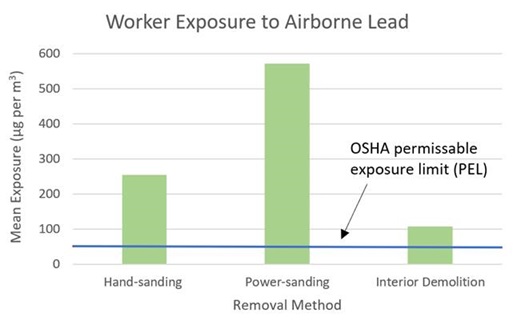by Erin Falvey — Although the IRS says it takes a commercial building 39 years to fully depreciate in value, owners and managers know that a well-maintained building maintains its value well beyond that mark. Still, by the time a building reaches its 50-year milestone, it may present its owners with challenges that resemble a mid-life crisis. Older buildings tend to have poor energy performance and often have many elements or systems that require replacement or restoration. There may also be a lack of documentation related to original design and construction, which can impede a full understanding and resolution of problems, especially those that are unforeseen. One common unforeseen condition in over-50 buildings is the presence of lead-based paint (LBP). Lead was widely used as a paint additive for decades, and although it was banned more than 40 years ago, building owners and managers are still struggling with its legacy today.
A brief history of paint
Paint is one of the earliest human inventions, appearing well before the wheel. It originated over 30,000 years ago in its most primitive form with paintings on cave walls, many of which survive today. Early human’s first painters used substances from nature such as ochre, charcoal, plants, berries, sands, and soils to create their paints, utilizing oil or water as a base. Early users soon realized that paint and coating mixtures could be used not just for aesthetic reasons, but to protect their materials. For example, the Ancient Egyptians used tar-based coatings to protect the wood of their ships. It wasn’t until 1700 when Thomas Child established the first recorded paint mill that paint was recognized as a lucrative product. Early sale and distribution of paint was largely decentralized, relying on small manufacturers because the product was so heavy and difficult to transport. The first patent for ready mixed paints was established in 1867, forever changing the way paint was produced and sold. Later during the Industrial Revolution, paints and coatings established their primary role in protecting a wide array of new commercial products while serving the dual purpose of making them aesthetically appealing for sale.
Paint chemistry
Today, paint is made from four components: resin (the binder), additives (the enhancers), solvent (the carrier), and pigment (the color). Modern resins include acrylic emulsion polymers, epoxies, alkyds, polyurethanes, and silanes. Additives provide improved performance such as mold and scuff resistance, and also modify drying times. Solvents disperse the other paint ingredients, creating consistency in application. Pigments provide color and come from ingredients such as titanium oxide, carbon, metallic salts, iron oxide, and cadmium. Without a doubt, the most controversial ingredient of paint is lead, which plays a dual role as both a pigment and an additive that decreases drying time.

Figure 1. Health effects of lead on the human body. (From U.S. Environmental Protection Agency, 2020)
The dangers of lead paints
The harmful effects of using lead as pigments have been known for many years. Painters in the 17th century were often exposed to lead poisoning when they created their own paints by hand, and the phrase “crazy as a painter” was common in that time. During the 19th century, lead began to be restricted from paints when metals such as zinc and titanium were found to be acceptable alternatives. Although awareness of lead poisoning in children dates to the early 20th century, it didn’t become a major health issue until the 1960s when childhood developmental delays and learning difficulties were tied directly to lead paint exposure, primarily through the ingestion of paint chips and breathing of dust (see Figure 1). In 1978, lead-based paints were finally banned by the Consumer Product Safety Commission. However, these paints remain ubiquitous in the built environment, and their presence can be a source of expense, confusion, and frustration for those responsible for maintaining old buildings.
Regulations, removal, and disposal
For anyone considering a restoration project involving lead paint, understand that two bodies regulate lead paint removal: The Environmental Protection Agency (EPA), whose goal is to protect building occupants, the general public, and the environment; and the Occupational Safety and Health Administration (OSHA), whose goal is to protect workers in the workplace. According to EPA’s Renovation Repair and Painting (RRP) regulations, a coating or paint is not considered “lead-based paint” unless it contains over 0.5% lead. The EPA notes that even for paints containing less lead than the regulated concentration, “lead dust can be released when the paint deteriorates, or is disturbed during remodeling, renovation, sanding, or some maintenance work that breaks the surface of the paint.” OSHA has a more stringent definition than EPA, calling substances with a lead concentration above 0% “lead containing coatings or paints,” which must then be handled appropriately for worker safety. This includes regulating any activity that disturbs paint (sanding, grinding, etc.) with any measurable content of lead. OSHA requires initial air monitoring at the beginning of work to establish exposure levels and determine if they fall under the action limit (AL) or the permissible exposure limit (PEL). These limits can be easily exceeded, even with paint under the EPA’s limit of 0.5% (see Figure 2).

Figure 2. Typical leaded dust concentrations in workers’ breathing zones during restoration and remodeling activities. (Data from U.S. Environmental Protection Agency, 1997)
As a restoration project proceeds, the waste must be handled properly. To speed up elimination of lead-based paints from residential properties where children may come in contact, the EPA made removal more affordable by allowing homeowners to dispose of lead-based paint waste in municipal or construction and demolition (C&D) landfills. The EPA extended this option to contractors but also encouraged them to take precautions and coordinate with local solid waste authorities. Conversely, waste from non-residential properties must be treated as toxic waste unless a toxicity characteristic leaching procedure (TCLP) analysis confirms that the samples fall below the toxicity threshold. State and local regulations vary so it may be helpful to conduct independent research or contact a subject matter expert.
Contractors involved with lead-based paint remediation may be required to have specialized training. Under the Toxic Substance Control Act (TSCA), the EPA has training and certification requirements for individuals conducting lead-based paint inspections, risk assessments, or abatement services in building such as residences, day-care centers, and some classrooms. The goal is to ensure contractors are well-qualified and that lead-based paint activities are conducted safely, reliably, and effectively.
The move toward sustainability in the coating industry
Paint can be considered one of the earliest sustainability products. After all, one of the primary goals of paints and coatings is to help extend the life of materials and products, including those in the built environment. Jennifer Gleisberg, a high-performance coatings sales manager, said “Really, the goal of every high-performance coating system is sustainability, because coatings guard surfaces against corrosion and UV light degradation, extending the life-cycle of a building.”
Gleisberg added that market forces within the building industry are pushing the coating industry toward more sustainable and environmentally friendly options, such as low or no-volatile organic compounds (VOC) options, which are now the industry norm.
“Sustainability standards like LEED v4 limit the amount of allowable emissions from coatings, and national air district regulations are also a huge factor when architects and specifiers are selecting coatings,” she said. “Both have been very effective in limiting the use of solvent-borne products, forcing the coatings industry to come up with innovative, low-emitting coating systems.”
Customers are also moving toward technologies that provide reduced environmental impact through lower application energy consumption, increased product lifecycle, and higher renewable content. For example, the process of recycling paint, where users return unused product for remanufacturing, was pioneered about 15 years ago. Manufacturers are searching for more natural or sustainable ingredients such as oil-based paints made from soybean or sunflower oil and resins containing recycled plastic water bottles. They are also finding new ways to minimize waste and increase process efficiency.
Another example of the move toward sustainable products is roof coatings (such as polymethyl-methacrylate, or PMMA, acrylic, or silicone) that can be fluid-applied directly over an existing roof to create a water-resistant layer (see Figure 3). With an expected life of 15 years (if properly maintained), these coatings allow owners to delay a more expensive replacement project by extending the life of their existing roof. In addition, these coatings can serve a second sustainability purpose: the reflectivity characteristic of the white coating helps the roof shed sunlight, especially during peak summer. Studies have found that the systematic implementation of white roofs may be able to reduce the “urban heat island” effect in a city by one to two degrees. Urban heat islands have temperatures that are significantly higher than their rural or suburban surroundings and can create health problems for urban residents, especially those that are at high risk from medical conditions like asthma and heart conditions.
The future of the coatings industry
From the removal of lead in the 1970s to the more recent reduction of VOCs, the coatings industry has continuously evolved to keep pace with regulatory and consumer needs. For manufacturers to effectively change with the changing times, they must consider industry trends and anticipate regulatory changes well before they are implemented. Industry leaders say there is movement towards sustainability standards as global awareness and consumer desire for green products increases. However, one challenge is the lack of global agreement on sustainability standards and the inconsistency of environmental regulations. Bringing consistency to sustainability goals will allow manufacturers to create the momentum that will drive innovative solutions. One area of continued focus will be sustainable high-performance, such as water-based, low-VOC paint products. Manufacturers hope to find a unique chemistry that offers the performance of solvent-borne coatings without the volatility of traditional formulas. As new information is unveiled and new technologies and innovations are developed, humans will keep trying to perfect the paint recipe they invented 30,000 years ago.
About the author
 Erin Falvey, E.I.T. is a Project Engineer at Facility Engineering Associates. She has a degree in Civil Engineering from the University of Virginia and works on delivering engineering solutions to clients to maximize the life of physical assets through repair and restoration projects in roofing, building exteriors, parking garages, and fall protection.
Erin Falvey, E.I.T. is a Project Engineer at Facility Engineering Associates. She has a degree in Civil Engineering from the University of Virginia and works on delivering engineering solutions to clients to maximize the life of physical assets through repair and restoration projects in roofing, building exteriors, parking garages, and fall protection.
